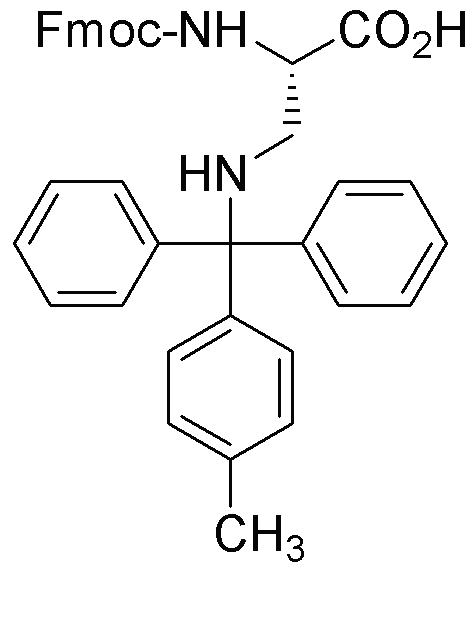Na-Fmoc-Nb-4-methyltrityl-L-2,3-diaminopropionic acid is widely utilized in research focused on:
- Peptide Synthesis: This compound serves as a crucial building block in the synthesis of peptides, allowing researchers to create complex structures with specific functionalities.
- Drug Development: Its unique properties make it valuable in the pharmaceutical industry for designing novel therapeutic agents, particularly in targeting specific biological pathways.
- Bioconjugation: The compound is employed in bioconjugation processes, facilitating the attachment of biomolecules to surfaces or other molecules, which is essential in developing biosensors and targeted drug delivery systems.
- Research in Protein Engineering: It is used in protein engineering studies to modify amino acid sequences, helping scientists understand protein function and stability better.
- Material Science: The chemical finds applications in creating advanced materials, particularly in the development of polymers with tailored properties for specific applications.
General Information
Properties
Safety and Regulations
Applications
Na-Fmoc-Nb-4-methyltrityl-L-2,3-diaminopropionic acid is widely utilized in research focused on:
- Peptide Synthesis: This compound serves as a crucial building block in the synthesis of peptides, allowing researchers to create complex structures with specific functionalities.
- Drug Development: Its unique properties make it valuable in the pharmaceutical industry for designing novel therapeutic agents, particularly in targeting specific biological pathways.
- Bioconjugation: The compound is employed in bioconjugation processes, facilitating the attachment of biomolecules to surfaces or other molecules, which is essential in developing biosensors and targeted drug delivery systems.
- Research in Protein Engineering: It is used in protein engineering studies to modify amino acid sequences, helping scientists understand protein function and stability better.
- Material Science: The chemical finds applications in creating advanced materials, particularly in the development of polymers with tailored properties for specific applications.
Documents
Safety Data Sheets (SDS)
The SDS provides comprehensive safety information on handling, storage, and disposal of the product.
Product Specification (PS)
The PS provides a comprehensive breakdown of the product’s properties, including chemical composition, physical state, purity, and storage requirements. It also details acceptable quality ranges and the product's intended applications.
Certificates of Analysis (COA)
Search for Certificates of Analysis (COA) by entering the products Lot Number. Lot and Batch Numbers can be found on a product’s label following the words ‘Lot’ or ‘Batch’.
*Catalog Number
*Lot Number
Certificates Of Origin (COO)
This COO confirms the country where the product was manufactured, and also details the materials and components used in it and whether it is derived from natural, synthetic, or other specific sources. This certificate may be required for customs, trade, and regulatory compliance.
*Catalog Number
*Lot Number
Safety Data Sheets (SDS)
The SDS provides comprehensive safety information on handling, storage, and disposal of the product.
DownloadProduct Specification (PS)
The PS provides a comprehensive breakdown of the product’s properties, including chemical composition, physical state, purity, and storage requirements. It also details acceptable quality ranges and the product's intended applications.
DownloadCertificates of Analysis (COA)
Search for Certificates of Analysis (COA) by entering the products Lot Number. Lot and Batch Numbers can be found on a product’s label following the words ‘Lot’ or ‘Batch’.
*Catalog Number
*Lot Number
Certificates Of Origin (COO)
This COO confirms the country where the product was manufactured, and also details the materials and components used in it and whether it is derived from natural, synthetic, or other specific sources. This certificate may be required for customs, trade, and regulatory compliance.


